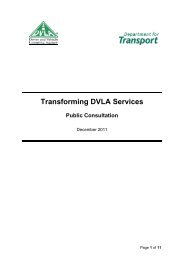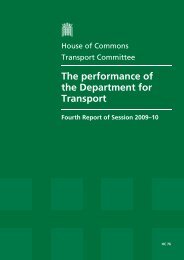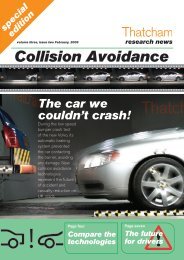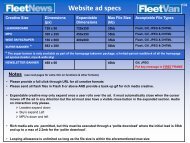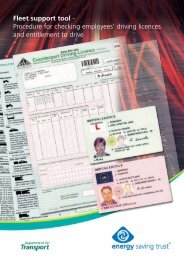Zurich Guide to Managing Grey Fleet Risks - Fleet News
Zurich Guide to Managing Grey Fleet Risks - Fleet News
Zurich Guide to Managing Grey Fleet Risks - Fleet News
Create successful ePaper yourself
Turn your PDF publications into a flip-book with our unique Google optimized e-Paper software.
Mobile phone use is another area where<br />
uniform management standards must<br />
apply. Best practice is not <strong>to</strong> allow any<br />
phone use whilst driving, but where this<br />
has not yet been implemented, just<br />
because an employee is using a privatelyfunded<br />
vehicle, organisations should not<br />
assume that they are exempt from any<br />
rules on phone use that exist – in fact this<br />
situation is often more difficult <strong>to</strong> manage,<br />
as the employee may have their own<br />
phone and is unlikely <strong>to</strong> have any funded<br />
hands-free equipment.<br />
Risk assessments are another area where<br />
consistent implementation is required.<br />
These are required as part of the risk<br />
management process (see page 8 earlier)<br />
and should give a comprehensive risk<br />
profile of each driver (including their core<br />
competencies) as well as for the journey<br />
and vehicle aspects (covered on pages<br />
15-16 later).<br />
Some organisations only risk assess their<br />
managed fleet employees, as they argue<br />
that these tend <strong>to</strong> be the highest mileage<br />
drivers and hence are at most risk of<br />
being involved in a collision. Others use<br />
the collision his<strong>to</strong>ry of an employee <strong>to</strong><br />
determine who needs assessing. Both of<br />
these approaches are flawed in that, until a<br />
risk assessment has been undertaken, it is<br />
not possible <strong>to</strong> determine where (and what)<br />
the actual risks are. Mileage exposure<br />
and collision his<strong>to</strong>ry are certainly indica<strong>to</strong>rs<br />
of risk, but a good comprehensive risk<br />
assessment will address many other issues<br />
and give an accurate indica<strong>to</strong>r of which<br />
employees are more likely <strong>to</strong> be involved<br />
in a collision. Indeed, the grey fleet driver,<br />
using these simple criteria, is unlikely ever<br />
<strong>to</strong> be assessed, as they tend <strong>to</strong> have lower<br />
mileage exposures and the organisation<br />
rarely has any collision data.<br />
Once the risk assessment process has<br />
been completed, the organisation can<br />
then decide on what the appropriate<br />
interventions are, and again, these<br />
should be applied uniformly regardless<br />
of vehicle ownership. As discussed earlier,<br />
risks should be addressed using a<br />
hierarchical approach (eliminate, substitute,<br />
reduce) with management interventions<br />
given priority as these are most likely <strong>to</strong><br />
produce a sustainable reduction in the<br />
risks faced.<br />
Where interventions focused<br />
on the individual are involved,<br />
there will generally be a cost<br />
implication (whether that is<br />
the employee’s time, organising<br />
an internal training course or<br />
undertaking some externallysupplied<br />
coaching). Any budgets<br />
for risk management must include<br />
the grey fleet, as these drivers<br />
will face similar risks <strong>to</strong> those in<br />
the managed fleet, and need <strong>to</strong><br />
be addressed in the same way.<br />
14



